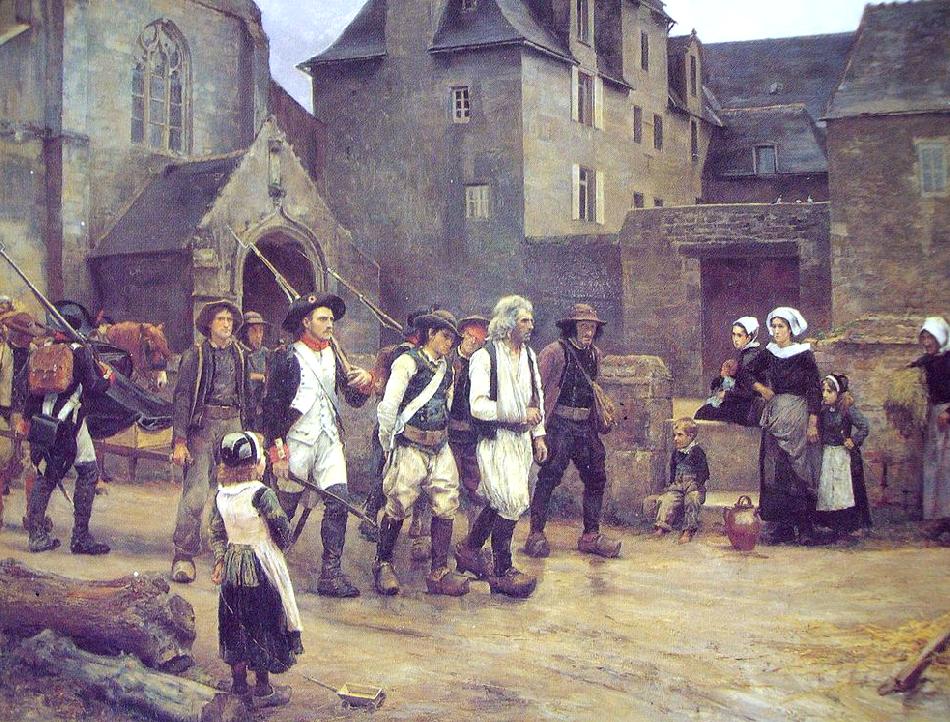
The French Revolution: The Provinces

Figure 1.-- The Revolution's foreign enemies formed the First Coalition and invaded France to save King Louis (1792). At the same time, domestic unrest broke out within France. Peasants, royalists, and suppoters of the Church rose up in the the provinces, especially in the west. Terrible attrocities were caried out by both sides. It was a regional civil war, fought as a guerilla war but there were several full-scale battles. Here several peasant rebels have been taken prisoner by the Republican National Guard of Quimper (1792). Quimper is a town in Britanty. It was entitled 'Les Révoltés de Fouesnant'. Fouesnant was a costal town south of Quimper. The artist was Jules Girardet (1856-1938). He painted this in 1886.
|
|
Paris from the earliest point in the French nation has played a major role Beginning with the fall of Bastille, Paris was the primary stage for the unfolding Revolution. Many view the Revolution as a Parisian phenomenon, playing out at the Bastille, Versailles, the Tuileries, the chambers of the Jacobin Club, and the Place de la Concorde. Paris became notorius for the Terror and the guillotine. TheTerror was, however, not restricted to Paris. There were outbreaks of terror throughout the provinces. [Ballard] There was also support for the monarchy in the provinces. The most serious was the War in the Vendée (1793-96). The Vendée is a coastal region south of Brittany bordered by the Loire River in west central France. Conditions in the Vendée were not as favorable to the Revolution as in Paris and many other regions of France. Class differences were not as pronounced. The Vendée was a relatively isolated province. The nobility was highly residential and seems to have maintained relatively good relations with the peasantry. There was also a strong devotion to the Catholic Church. Problems began with the Civil Constitution of the Clergy (1790). Agents informed the Convention of
the disturbing opposition to the Revolution in the Vendée (1791). The Marquis de la Rouerie organized a royalist
plot. The breaking point was the National Convention's decision to expand the army with a levy of 300,000 men
(February 1793). The Vendée erupted. One of the martial myths of the Revolution came out of the fighting in the
Vendée--Joseph Barra. The Jacobins described his attackers as 'brigands', but they were presumably peasants defending the church and monarchy. Another royalist revolt was the Chouannerie. Chouan (meaning 'the silent one' or 'owl') is a French surname. It was adopted as a nom de guerre by the Chouan brothers, especially Jean Cottereau, who styled himself Jean Chouan,. He heelped organize the anti-republican forces in Bas-Maine. Fighters in the revolt and then French royalists in general began to be called Chouans and the wider revolt the Chouannerie. It eventually enveloped the 12 of the western départements of France, particularly in the provinces of Brittany and neighboring Maine. It was similar to the Vendée, but ws centered north rather than south of the Vendeé River. At times the headquarters was in London. The Chouannerie was fought out primarily during the Directory and was no ended until Napoleon seized power (spring of 1794 until 1800). There were three destinct phases. The Association bretonne attempted to defend the monarchy and reinstate the laws and customs of Brittany that the Republic had repealed (1789). The Chouannerie began in force like the Vendeé revolt with the Civil Constitution of the Clergy and the levée en masse ordered by the National Convention. The first disturbances occurred (1792) and evolved to a peasant revolt like the medieval Jacquerie. Than guerrilla warfare began which evolved into actual large-scale bsttles. Finally the Republican/Imperial forces previled (1800). More localized peasant uprisings occurred in other départements (Aveyron and Lozère) which were also called 'chouanneries', but were much smaller.
Sources
Ballard, Ruchard. The Unseen Terror: The French Revolution in the Provinces.
CIH

Navigate the Children in History Website:
[Return to Main French Revolution page]
[Return to Main French history page]
[Return to Main revolutions page]
[Introduction]
[Animals]
[Biographies]
[Chronology]
[Climatology]
[Clothing]
[Disease and Health]
[Economics]
[Ethnicity]
[Geography]
[History]
[Human Nature]
[Law]
[Nationalism]
[Presidents]
[Religion]
[Royalty]
[Science]
[Social Class]
[Bibliographies]
[Contributions]
[FAQs]
[Glossaries]
[Images]
[Links]
[Registration]
[Tools]
[Children in History Home]
Created: 12:21 PM 10/9/2015
Last updated: 1:17 AM 10/10/2015



